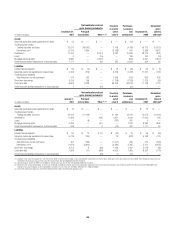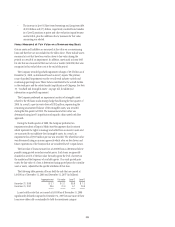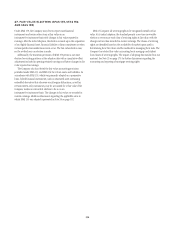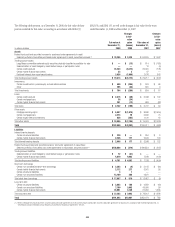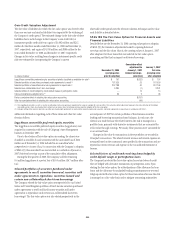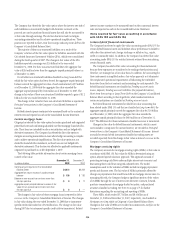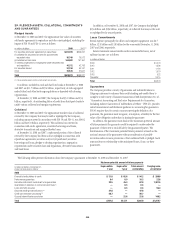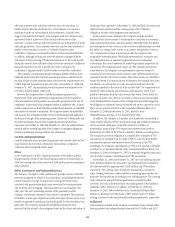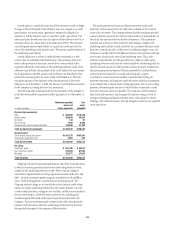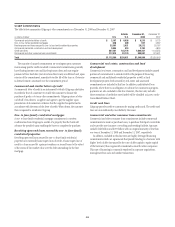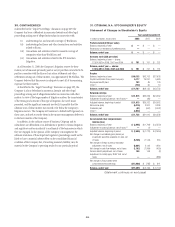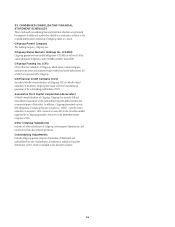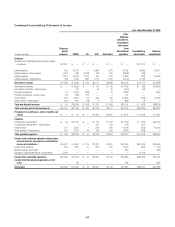Citibank 2008 Annual Report Download - page 215
Download and view the complete annual report
Please find page 215 of the 2008 Citibank annual report below. You can navigate through the pages in the report by either clicking on the pages listed below, or by using the keyword search tool below to find specific information within the annual report.
Maximum potential amount of future payments
Carrying value
(in millions)
In billions of dollars at December 31,
except carrying value in millions
Expire within
1 year
Expire after
1 year
Total amount
outstanding
2007 (2)
Financial standby letters of credit $ 43.5 $ 43.6 $ 87.1 $160.6
Performance guarantees 11.3 6.8 18.1 24.4
Derivative instruments considered to be guarantees 4.2 0.7 4.9 163.0
Loans sold with recourse — 0.5 0.5 45.5
Securities lending indemnifications (1) 153.4 — 153.4 —
Credit card merchant processing (1) 64.0 — 64.0 —
Custody indemnifications and other — 53.4 53.4 306.0
Total $276.4 $105.0 $381.4 $699.5
(1) The carrying values of guarantees of collections of contractual cash flows, securities lending indemnifications and credit card merchant processing are not material, as the Company has determined that the amount and
probability of potential liabilities arising from these guarantees are not significant.
(2) Reclassified to conform to the current period’s presentation.
Financial Standby Letters of Credit
Citigroup issues standby letters of credit which substitute its own credit for
that of the borrower. If a letter of credit is drawn down, the borrower is
obligated to repay Citigroup. Standby letters of credit protect a third party
from defaults on contractual obligations. Financial standby letters of credit
include guarantees of payment of insurance premiums and reinsurance risks
that support industrial revenue bond underwriting and settlement of
payment obligations to clearing houses, and also support options and
purchases of securities or are in lieu of escrow deposit accounts. Financial
standbys also backstop loans, credit facilities, promissory notes and trade
acceptances.
Performance Guarantees
Performance guarantees and letters of credit are issued to guarantee a
customer’s tender bid on a construction or systems-installation project or to
guarantee completion of such projects in accordance with contract terms.
They are also issued to support a customer’s obligation to supply specified
products, commodities, or maintenance or warranty services to a third party.
Derivative Instruments Considered to Be Guarantees
Derivatives are financial instruments whose cash flows are based on a
notional amount or an underlying instrument, where there is little or no
initial investment, and whose terms require or permit net settlement.
Derivatives may be used for a variety of reasons, including risk management,
or to enhance returns. Financial institutions often act as intermediaries for
their clients, helping clients reduce their risks. However, derivatives may also
be used to take a risk position.
The derivative instruments considered guarantees, which are presented in
the table above, include only those instruments that require Citi to make
payments to the counterparty based on changes in an underlying that is
related to an asset, a liability, or an equity security held by the guaranteed
party. More specifically, derivative instruments considered guarantees
include certain over-the-counter written put options where the counterparty
is not a bank, hedge fund or broker-dealer (such counterparties are
considered to be dealers in these markets, and may therefore not hold the
underlying instruments). However, credit derivatives sold by the Company
are excluded from this presentation, as they are disclosed separately within
this note below. In addition, non-credit derivative contracts that are cash
settled and for which the Company is unable to assert that it is probable the
counterparty held the underlying instrument at the inception of the contract
also are excluded from the disclosure above.
In instances where the Company’s maximum potential future payment is
unlimited, the notional amount of the contract is disclosed.
Guarantees of Collection of Contractual Cash Flows
Guarantees of collection of contractual cash flows protect investors in credit
card receivables securitization trusts from loss of interest relating to
insufficient collections on the underlying receivables in the trusts.
Loans Sold with Recourse
Loans sold with recourse represent the Company’s obligations to reimburse
the buyers for loan losses under certain circumstances. Recourse refers to the
clause in a sales agreement under which a lender will fully reimburse the
buyer/investor for any losses resulting from the purchased loans. This may
be accomplished by the seller’s taking back any loans that become
delinquent.
Securities Lending Indemnifications
Owners of securities frequently lend those securities for a fee to other parties
who may sell them short or deliver them to another party to satisfy some
other obligation. Banks may administer such securities lending programs for
their clients. Securities lending indemnifications are issued by the bank to
guarantee that a securities lending customer will be made whole in the event
that the security borrower does not return the security subject to the lending
agreement and collateral held is insufficient to cover the market value of the
security.
Credit Card Merchant Processing
Credit card merchant processing guarantees represent the Company’s
indirect obligations in connection with the processing of private label and
bankcard transactions on behalf of merchants.
Citigroup’s primary credit card business is the issuance of credit cards to
individuals. In addition, the Company provides transaction processing
services to various merchants with respect to bankcard and private-label
cards. In the event of a billing dispute with respect to a bankcard transaction
between a merchant and a cardholder that is ultimately resolved in the
cardholder’s favor, the third party holds the primary contingent liability to
credit or refund the amount to the cardholder and charge back the
transaction to the merchant. If the third party is unable to collect this
amount from the merchant, it bears the loss for the amount of the credit or
refund paid to the cardholder.
The Company continues to have the primary contingent liability with
respect to its portfolio of private-label merchants. The risk of loss is mitigated
as the cash flows between the third party or the Company and the merchant
are settled on a net basis and the third party or the Company has the right to
209


